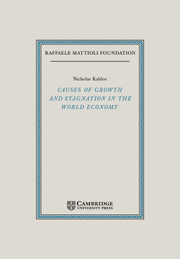Book contents
- Frontmatter
- Contents
- Preface
- Acknowledgements
- CAUSES OF GROWTH AND STAGNATION IN THE WORLD ECONOMY
- FIRST LECTURE Equilibrium Theory and Growth Theory
- SECOND LECTURE Alternative Approaches to Growth Theory
- THIRD LECTURE The Problem of Intersectoral Balance
- FOURTH LECTURE The Effects of Interregional and International Competition
- FIFTH LECTURE Policy Implications of the Current World Situation
- DISCUSSION
- NICHOLAS KALDOR, A BIOGRAPHY, by A. P. Thirlwall
- BIBLIOGRAPHY OF THE WORKS OF NICHOLAS KALDOR, compiled by Ferdinando Targetti
- BIBLIOGRAPHY OF WORKS CITED
- LIST OF ABBREVIATIONS
- INDEX
- Cambridge Cultural Social Studies
THIRD LECTURE - The Problem of Intersectoral Balance
Published online by Cambridge University Press: 23 December 2009
- Frontmatter
- Contents
- Preface
- Acknowledgements
- CAUSES OF GROWTH AND STAGNATION IN THE WORLD ECONOMY
- FIRST LECTURE Equilibrium Theory and Growth Theory
- SECOND LECTURE Alternative Approaches to Growth Theory
- THIRD LECTURE The Problem of Intersectoral Balance
- FOURTH LECTURE The Effects of Interregional and International Competition
- FIFTH LECTURE Policy Implications of the Current World Situation
- DISCUSSION
- NICHOLAS KALDOR, A BIOGRAPHY, by A. P. Thirlwall
- BIBLIOGRAPHY OF THE WORKS OF NICHOLAS KALDOR, compiled by Ferdinando Targetti
- BIBLIOGRAPHY OF WORKS CITED
- LIST OF ABBREVIATIONS
- INDEX
- Cambridge Cultural Social Studies
Summary
In our last lecture we considered how Keynes' short period equilibrium model gave rise to models of a steadily growing economy where the steady growth of the physical capacity to produce output (resulting from past investment) went hand-in-hand with the growth of the demand for consumable output, which in turn was “fed” by the growth in the volume of investment which generated an increase in the demand for consumer goods; and the latter, in turn, justified new investment decisions on an increasing scale. It was the discovery of Harrod and Domar which showed that with a given capital coefficient there is only one particular rate of growth which will generate a growth of demand that corresponds to the growth of productive capacity, and for that reason it could maintain itself indefinitely.
I do not wish to repeat the objections to this kind of model which takes too many factors as exogenously given and which takes no account of the structural problems of economic growth. This treatment of the problem is no different from assuming that production consists of a single homogeneous commodity which is either consumed or accumulated. Hence these models have come to be called “single sector” models, to distinguish them from “multi-sector” models which take into account the mutual interdependence (or complementarity) of different sectors, the development of each of which is closely dependent on, and also stimulated by, the development of the others.
The traditional distinction between economic sectors is that between primary, secondary and tertiary activities.
- Type
- Chapter
- Information
- Causes of Growth and Stagnation in the World Economy , pp. 39 - 54Publisher: Cambridge University PressPrint publication year: 1996
- 1
- Cited by



